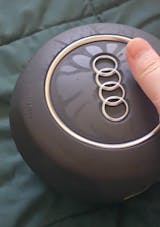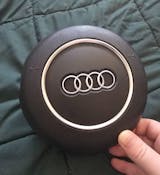It appears that your cart is currently empty
How to replace steering wheel?
Replacing a steering wheel is a technical yet rewarding process that enhances both aesthetics and driving comfort. Whether upgrading to a sportier model or replacing a worn-out unit, understanding the removal and installation procedure ensures a safe and precise fit. This guide covers essential steps, technical considerations, and best practices for selecting the ideal replacement.
In this article, you'll learn:
Why replace your steering wheel?
A steering wheel serves as the primary interface between driver and vehicle, influencing handling precision and driving ergonomics. Over time, factory-installed wheels may deteriorate, lack modern features, or fail to suit a driver's preferences. Performance-focused replacements-such as Alcantara, perforated leather, or carbon fiber variants-can improve grip and driving dynamics. Many manufacturers, including Audi, BMW, Mercedes-Benz, and Porsche, offer OEM-quality replacements tailored for both aesthetics and function.
Step-by-Step guide to steering wheel replacement
1. Pre-removal safety measures
Before removing the steering wheel, disconnect the vehicle's battery to prevent unintended airbag deployment. Allow at least 15 minutes for residual charge to dissipate from the Supplemental Restraint System (SRS). If the vehicle has an active power steering column adjustment, ensure it is set to a neutral position.
2. Removing the airbag module
Most modern steering wheels feature integrated airbags. Locate the rear access points-typically small openings on the backside of the wheel-to disengage the airbag's retaining clips. Use a precision tool, such as a flathead screwdriver or a specific manufacturer-designed airbag release tool.
-
Gently disconnect all airbag wiring to prevent damage to harness connectors.
-
Handle the airbag module with care-static discharge can compromise functionality.
-
Place the airbag facing upward on a flat surface to minimize deployment risk.
3. Steering wheel detachment
Once the airbag module is removed, locate the central locking bolt securing the wheel to the column. Use an appropriately-sized torque wrench to loosen the bolt without excessive force. Before removing the wheel, mark its alignment position relative to the steering column to ensure precise reinstallation.
If the steering wheel proves difficult to remove manually, employ a steering wheel puller designed for your vehicle type to prevent excessive strain on internal components.
Installing the new steering wheel
1. Positioning & alignment
It is advisable to obtain a new steering wheel bolt instead of reusing the old one. Before securing the new wheel, verify that it aligns with previously marked steering column positions. Any deviation can disrupt straight-line driving and affect steering calibration.
2. Wiring & control integration
Modern steering wheels often feature controls for infotainment, paddle shifters, or adaptive driving assistance systems. When replacing a wheel with multifunction buttons:
-
Confirm proper electrical pin compatibility with the vehicle's control system.
-
If necessary, consult an OBD-II coding tool to program button functionality.
-
Double-check airbag compatibility to ensure seamless integration.
3. Securing the wheel
Using a torque wrench, tighten the central bolt to manufacturer specifications-incorrect torque values can cause steering instability. Reconnect all wiring, ensuring harnesses are correctly seated.
Once assembled, gently press the airbag module into place. Perform a system check by turning on the ignition and ensuring no error lights (such as the SRS warning) appear.
Legal & safety considerations
Before replacing an airbag-equipped steering wheel, verify local regulations regarding vehicle modifications. In certain regions, replacing a wheel without an airbag may compromise roadworthiness certification. Always refer to manufacturer documentation to confirm compatibility.
Selecting the right steering wheel
When researching steering wheel replacements, consider:
OEM vs. aftermarket compatibility - Ensure proper fitment with existing wiring.
Material choices - Alcantara, perforated leather, and carbon fiber improve grip.
Multifunction controls - Verify whether your new wheel supports key features.
Steering diameter and thickness - Adjust for enhanced handling precision.
Companies and tuning shops like AGE Styling offer model-specific, high-quality steering wheels designed for BMW, Audi, Porsche, Mercedes-Benz, and Volkswagen - ensuring optimal fitment and performance.
Final thoughts
Replacing a steering wheel is a technical yet rewarding upgrade that enhances both the driving experience and vehicle interior aesthetics. Whether swapping for a motorsport-inspired design or restoring worn materials, ensuring proper alignment, wiring integration, and safety compliance guarantees a smooth installation.
Browse AGE Styling's premium steering wheel selection to find a model that complements your car's performance and design.






0 comments